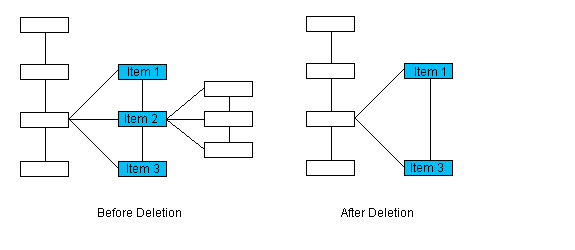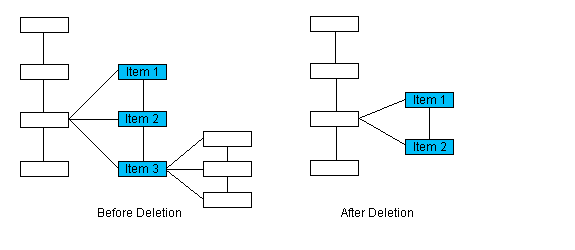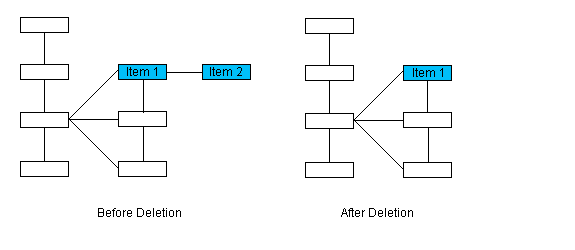| Visual Basic (Usage) |  Copy Code Copy Code |
|---|---|
| |
Parameters
- iod
- The item to be deleted.
Return Value
A DicomIod class that contains adjacent item. If the item being deleted has a sibling (same level, same parent), following it, the returned class will be this sibling. If the item being deleted does not have a sibling following it, but has a sibling preceding it, the returned pointer class will be the preceding sibling. If the item being deleted is an only child, the returned class will be the parent.For an example, refer to Reset.
You can remove all items from the IOD Structure using Reset. Since the IOD Structure is stored internally as a tree, the deletion must be carried out as a tree. Since the IOD Structure is stored internally as a tree, the deletion must be carried out as a tree. Below are illustrations of these situations:
For the sake of these illustrations, the order of siblings is top to bottom. A preceding sibling is drawn above the sibling it precedes, a following sibling is drawn below the sibling it follows.
Please note that the numbering of the items of interest is arbitrary, and does not imply order.
In this illustration item 2 will be deleted. Since it has a following sibling, the returned class will be item 3.
In this illustration item 3 will be deleted. Since it does not have a following sibling, but does have a preceding sibling, the returned class will be item 2.
In this illustration item 2 will be deleted. Since it is an only child, the returned class will be the parent, item 1.
In this illustration item 1 will be deleted. Since it has no siblings and no parent, this method will return null.
Target Platforms: Microsoft .NET Framework 2.0, Windows 98, Windows NT 4.0, Windows Millennium Edition, Windows 2000, Windows XP Home Edition, Windows XP Professional, Windows Server 2003 family
Reference
DicomIodTable ClassDicomIodTable Members
Reset Method
GetFirst Method
GetLast Method
GetPrevious Method
GetNext Method
GetRoot Method
GetParent Method
GetChild Method
Find(DicomIod,DicomClassType,DicomIodType,Boolean) Method
FindClass Method
FindModule Method
FindModuleByIndex Method
Insert(DicomIod,Boolean,DicomClassType,String,DicomIodType,DicomIodUsageType,String) Method




